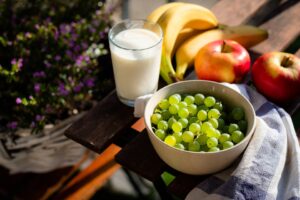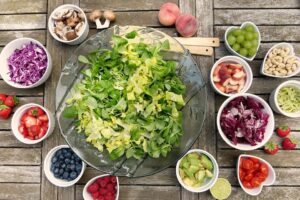Consistent workouts and a structured diet plan are key to achieving fitness goals. A balanced gym nutrition plan can help you optimize your performance, build muscles, reduce fat and improve overall health. This comprehensive guide covers key aspects of a fitness diet plan. It provides a detailed approach for meal planning, macronutrient breaks downs, and important tips for success.
1. Understanding Macronutrients
Macronutrients are carbohydrates, proteins and fats. They make up the main components of a healthy diet. Each one plays a vital role in promoting gym performance and recovery.
- Carbohydrates: The main source of energy for the body. These are vital for fueling your workouts and assisting in recovery. Your carbohydrate intake should be dominated by complex carbohydrates like whole grains, legumes, vegetables and fruits.
- Essential for muscle growth and repair. Lean meats and fish, dairy products, legumes and plant-based protein sources like tofu or quinoa are good sources.
- Fats are important for hormone production, absorption of nutrients, and general health. Choose healthy fats such as avocados, nuts and seeds, olive oil, and other sources.
2. Caloric Intake versus Macronutrient Ratios
To create a gym diet, you must first determine your daily caloric requirements. It depends on the goals you have (e.g. weight loss, muscle growth, maintenance), your age, gender and weight, as well as height and activity levels. Online calculators are available to estimate your basal metabolic rate (BMR) or Total Daily Energy Expenditure.
You can then adjust your macronutrients to meet your needs. For muscle gain, a typical macronutrient proportion might be 40% carbohydrate, 30% protein and 30% fat. For weight loss, the ratio is usually 40% protein, 30% carbohydrate, and 30% fat.
3. When and how often to eat meals
Regular eating can maintain energy and promote muscle recovery. Here’s how you can structure your daily meals:
- Breakfast: A balanced breakfast with complex carbohydrates, protein and healthy fats.
- Pre Workout Snack: Choose carbs that are easily digestible and moderate amounts of protein as fuel for your workout.
- Post Workout Meal Combination of carbs and protein to replenish glycogen and promote muscle recovery.
- Lunch: An equal-portioned meal, similar to the breakfast, but with more emphasis on vegetables, lean proteins, and whole grains.
- Dinner Lighter meal with healthy fats and vegetables low in carbs.
- Snacks: Include protein-rich snacks like Greek yogurt, nuts, or protein bars between meals if needed.
4. Sample Diet Plan
Here is a sample diet plan for someone who wants to gain muscle and have energy throughout the day.
Breakfast:
- 3 scrambled eggs
- 1 cup oatmeal with berries
- Almond butter, 1 tablespoon
- Green tea or water?
Mid-Morning Snack:
- Greek yogurt with honey, mixed nuts and a small amount of honey
Lunch:
- Grilled chicken breast
- Quinoa Salad with Vegetables
- Small avocado
- Drinking water or herbal tea
Pre-Workout Snack:
- Banana
- One scoop of protein powder in water
Post-Workout Meal:
- Grilled Salmon
- Sweet potato
- Broccoli steamed
Dinner:
- Turkey meatballs
- Salad of mixed greens with olive oil dressing
- Roasted Brussels sprouts as a side dish
Evening Snack (optional):
- Honey drizzled on cottage cheese
5. Hydration
It is important to stay hydrated for your overall health as well as your performance in the gym. Drink at least 8-10 glasses water per day. You can adjust your water intake according to your individual needs, your level of activity, the climate and your weather. Water consumption before, during and after exercise helps to maintain fluid balance, which supports muscle function.
6. Supplements
Supplements can fill in nutritional gaps to help you achieve your fitness goals.
- Powdered Protein: Ideal for supplying protein, particularly post-workout.
- Creatine: Increases muscle strength and mass.
- Branched Chain Amino Acids: Supports muscle recovery and reduces exercise-induced fatigue.
- Omega-3 fatty acids: Promote heart and inflammation health.
- Multivitamins: Make sure you are getting enough vitamins and minerals.
7. Special Considerations
Nutritional needs vary from person to person depending on factors like age, gender and health. Here are a few specific things to consider:
- Vegetarian/Vegan diets: Make sure you get enough protein from plant-based foods like lentils and beans. Supplements like iron, vitamin B12 and omega-3s are recommended.
- Food Allergies/Intolerances: Plan meals around safe foods and consider alternatives to common allergens like dairy, gluten, or nuts.
- Weight loss goals: Aim for a small caloric deficit and a high intake of protein, along with regular physical activity. Choose fiber-rich food to increase satiety.
8. Monitoring Progress
You can stay on track by tracking your progress regularly. Here are some ways you can monitor your progress.
- Keep a Food Journal: Documenting your eating habits can help you to identify patterns and make adjustments.
- Track macros and calories: Use an app like MyFitnessPal for monitoring your intake.
- Measure Performance: Keep track of your workouts, noting improvements in strength and endurance.
- Measure Body Composition: Measure body weight, muscle mass and fat percentage.
9. Plan Your Adjustment
As you continue to improve your fitness, your dietary requirements may change. Reassess regularly your goals, and make adjustments to your diet plan. Here are some tips to help you make adjustments:
- Increase calories for muscle gain: As muscle mass increases, it is possible that you will need to increase the caloric intake.
- Adjust Macros for Fat Loss: If weight loss stalls, consider adjusting your macronutrient ratios or increasing physical activity.
- Include Variety: To avoid dietary boredom, and to ensure a variety of nutrients, incorporate new foods and recipe regularly.
10. Sample Weekly Meal Plan
Here is a weekly sample meal plan which includes a wide variety of food and ensures that you get a balanced intake.
Monday:
- Breakfast: Eggs scrambled with spinach on whole grain toast
- Snack : Apples with almond butter
- Lunch: Mixed greens with cherry tomatoes and vinaigrette, grilled chicken salad.
- Snack: Greek Yogurt with Berries
- Dinner: Salmon, Quinoa and Steamed Asparagus
Tuesday:
- Breakfast: Oats overnight with chia seed, banana and protein powder
- Snack : Carrot Sticks with Hummus
- Lunch: Turkey & Avocado Wrap with Whole-Grain Tortilla
- Snack : Cottage Cheese with Pineapple Chunks
- Dinner: Stir fried tofu, mixed vegetables, and brown rice
Wednesday:
- Breakfast: Smoothie made with spinach, almond milk, protein powder and frozen berries
- Snack : Hard-boiled Eggs
- Lunch: Lentil Soup with Whole-Grain Bread
- Snack : A protein shake and a handful nuts
- Dinner: Shrimp, sweet potato and a salad
Thursday:
- Breakfast: Omelette stuffed with bell peppers and onions, mushrooms
- Snack : Pear and a handful walnuts
- Lunch: Quinoa, black beans and salsa with avocado
- Snack: Edamame
- Dinner: Stir-fried chicken with broccoli, bell pepers, and brown rice
Friday:
- Breakfast: Greek Yogurt Parfait with Granola and Mixed Berries
- Snack: Protein bar
- Lunch: Mixed greens with cucumber and a light salad dressing.
- Snack : Smoothie made with pineapple, kale and protein powder
- Dinner: baked cod, roasted potatoes, and green beans
Saturday:
- Breakfast: Whole grain pancakes with almond and banana butter
- Snack : Celery Sticks with Peanut Butter
- Lunch: Chickpeas and vegetables curry with Basmati rice
- Snack: Cheese sticks
- Dinner: Stir-fried beef with mixed vegetables, quinoa and mixed vegetables
Sunday:
- Breakfast: Burrito breakfast with scrambled egg, black beans and salsa.
- Snack : Mixed Fruit Bowl
- Lunch: Turkey Burger with whole-grain bread and sweet potato fries
- Snack: Protein shake
- Dinner: Wild rice, grilled chicken breast and roasted Brussels sprouts
11. Tips for Success
- Plan ahead: Prepare healthy meals in advance so that you always have options available.
- Be Consistent: Your fitness goals will be achieved if you stick to your diet.
- Listen To Your Body: Pay Attention to How Your Body Responds to Different Foods and Adjustments.
- Seek Professional Advice: Consult with a dietitian or nutritionist for personalized advice.
Conclusion
It is important to have a well-structured diet plan for your gym workouts if you want to achieve the best results. Understanding macronutrients and managing your caloric intake is key to achieving your fitness goals. Stay hydrated and consider taking supplements if necessary. Monitor and adjust your plan regularly to ensure progress. You can achieve a healthy diet with consistency and dedication.


